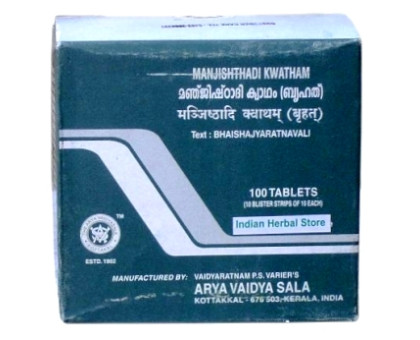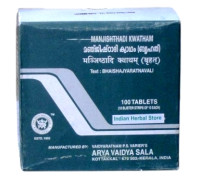
हम वर्तमान में अनुवाद पर काम कर रहे हैं, और यह जल्द ही हमारी वेबसाइट पर उपलब्ध होगा। इस बीच, हम आपको अंग्रेजी में एक विवरण दे रहे हैं। असुविधा के लिए खेद है।
Manjishtadi kwath is a complex medicine from Kerala ayurvedic tradition, based on “classical” Manjishta formula.
Manjishta is considered to be the best medicine in ayurvedic tradition for metabolism and blood purification. It is one of the main herbs, which decrease Pitta-dosha efficiently.
Manjishtadi kwath expels toxins from the blood stream, prevents thrombosis and improves general and local blood circulation. Due to its unique properties Manjishtadi kwath heals damaged tissues, bone fractures, stimulates resorption of benign and malignant tumors.
It is an excellent anti-inflammatory medicine in gynecological sphere.
Manjishtadi kwath regulates function of the main organs of excretion, as kidneys, liver and spleen, causing excellent purifying effect.
In rashes and skin inflammations Manjishtadi kwath is applied locally as a honey paste.
In skin burns and damaged tissues, Manjishtadi kwath is also applied locally as a licorice paste to relieve pain.
Manjishtadi kwath benefits:
- a powerful purifying medicine, which stimulates function of the main organs of excretion (liver, kidneys, spleen);
- an excellent anti-inflammatory medicine in gynecological sphere;
- it is helpful in treatment of benign and malignant tumors due to its purifying and resorptive properties;
- it heals damaged tissues, bone fractures, improves general and local blood circulation;
- it inhibits genital herpes activity.
Indications: amenorrhea, dysmenorrhea, menorrhagia, climacteric period, urolithiasis, jaundice, ascites, paralysis, skin rashes, herpes infection (type I), bone fractures.
Content:
Manjishtha - Rubia cordifolia, Musta - Cyperus rotundus, Kutaj - Holarrhena antidysenterica, Guduchi - Tinospora cordifolia, Erand - Ricinus communis, Sunthi - Zingiber officinale, Bharang - Clerodendrum serratum, Kantkari - Solanum surattense, Vacha - Acorus calamus, Nimba - Azadirachta indica, Haridra - Curcuma longa, Daruharidra - Berberis aristata, Haritaki - Terminalia chebula, Bibhitak - Terminalia belerica, Amalaki - Emblica officinalis, Patola - Trichosanthes dioica, Katuki - Picrorhiza kurroa, Royle Nasottar - Operculina turpethum, Vidang - Embelia ribes, Asana - Pterocarpus marsupium, Chitrak - Plumbago zeylanica, Shatavari - Asparagus recemosus, Trayman - Gentina kurroo, Pippali - Piper longum, Indrajav - Holarrhena antidysenterica, Vasa - Adhatoda vasica, Bhringraj - Eclipta alba, Devdaru - Cedrus deodara, Patha - Cissampelos pareira, Khadira - Acacia catechu, Varun - Crataeva nurvala, Kalmegha - Andographis paniculeta, Bakuchi - Psoralea corylifolia, Aragvadha - Cassia fistula, Shakothak - Streblus asper Bakayan, Nimb - Melia azedarach, Karanj - Pongomia pinnata, Ushir - Vetiveria zizanioides, Indravaruni - Citrullus colocynthis, Anatmul - Hemidesmus indicus, Parpatak – Fumaria, Kutaj - Holarrhena antidysenterica parviflora, Guduchi - Tinospora cordifolia.
Dosage/Application:
1 गोलियां twice a day, or as prescribed by physician.
This remedy is not a product of allopathic medicine. Mostly, it considered as food supplement that can be used only as a addition to the diet. All information on the treatment of diseases with this product is based on the knowledge of Ayurveda, phytotherapy and nutrition and is not confirmed by the Ukrainian Ministry of Health or other competent organizations and can only be used for reference.

